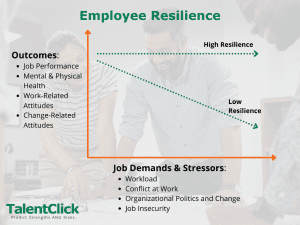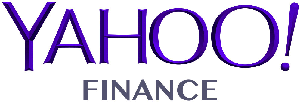The world as we know it is one of constant change, requiring employees to face increasing variability both at work and at home.
Whether it’s looming stress and fear, tight deadlines, or the challenges of working from home, workers are constantly navigating stressful situations while trying to reach their goals. Identifying an employee’s capacity for resilience can help determine their suitability to the demands of your work environment.
As a leader, you may be searching for ways to support your team, retain top employees, and reduce absenteeism. This article will help you understand resilience to build teams that maintain or exceed expectations despite demanding circumstances.
What is Resilience?
Resilience is an individual’s capacity to constructively adapt to stress and adversity. Specifically, resilience moderates the relationship between workplace demands and individual or organizational outcomes.
In other words, high resilience buffers the negative effects of stress and adversity so workers can maintain their previous levels of wellbeing and performance. In contrast, low resilience exacerbates the effects of stress that lead to adverse outcomes.
As pressure builds in the workplace, understanding a worker’s resilience will help predict if they will thrive and survive.
Why is Resilience Important?
Research has shown that workers with higher resilience are more likely to experience positive outcomes in the workplace, including:
- Performance – Highly resilient workers have increased supervisor-rated job performance¹ and extra-role performance².
- Mental & Physical Health – Workers with low resilience are more likely to experience burnout and emotional exhaustion3,4.
- Work-Related Attitudes – Highly resilient employees have higher job satisfaction5, work engagement6, and organizational commitment7.
- Change-Related Attitudes – Employees with high resilience are open and committed to change in the workplace8,9.
Predict Resilient Traits:
Having highly resilient employees can increase positive workplace behavior and lead to productive outcomes. Finding resilient workers may be your next hurdle.
Resilience is a complex topic that is predicted by an interplay of personal and environmental factors10. One well-researched driver of resilience is an individual’s traits and characteristics.
To help, we have mapped the traits that are highly predictive of employee resilience to TalentClick’s dimensions from our Attitude-Values-Personality (AVP) core bundle. Here are the top 6 traits to look for when searching for highly resilient workers:
1. Reactive/Anxious vs. Calm (WPP & SQ)
Highly Calm individuals are, by nature, less affected by stress, changing circumstances, and high-pressured situations. These individuals are naturally resilient to workplace stress. Where they fall in this dimension will also help inform how an individual’s other traits interact with their ability to be resilient.
| From the Research: A person’s tendency to remain emotionally stable and balanced is positively related to general resilience in the workplace11. |
2. Positivity (WVA)
Individuals who are high in Positivity maintain an optimistic outlook and generally experience positive emotions at work. Highly positive individuals tend to be more resilient because they easily see the upside when facing new situations.
| From the Research: Maintaining a positive attitude12 and experiencing positive emotions13 fosters resilience during an organizational crisis. |
3. Responsibility (WVA)
Individuals who are high in Responsibility are driven to meet expectations and timelines. These individuals will continue to stick to a schedule and work hard to follow through on commitments despite obstacles.
| From the Research: The tendency to be conscientious (i.e., responsible, hardworking, and organized) is positively related to general resilience in the workplace11. |
4. Conventional vs. Open-Minded (WPP)
Highly Open-Minded individuals enjoy innovative ideas and new experiences. During stressful or uncertain times, they tend to remain agile and adapt easily to changes arising. They enjoy finding creative solutions to problems and are more likely to view obstacles as an opportunity to innovate.
| From the Research: Openness to experience positively predicts resilience11. |
5. Coachability (WVA)
Individuals who are high in Coachability have a stronger sense of self-awareness and the tendency for self-reflection. These individuals tend to actively seek feedback and ask the questions needed to positively adapt to adversity in the workplace. They enjoy learning and are more likely to use adversity as an opportunity to improve personally.
| From the Research: The tendency for self-reflection14, feedback from others15, and propensity for learning9, have positive relationships with resilience. |
6. Open Communication (WVA)
Individuals who are high in Open Communication readily share thoughts, feelings, and opinions with others. These workers are more likely to reach out to others during times of stress and foster the social support and collaborative work environment that, in turn, predicts resilience among workers.
| From the Research: Social support is positively related to resilience9 as it provides the opportunity to talk about and work through stressful experiences with others16. |
Resilience is complex. Understanding which traits an individual relies on to overcome adversity is critical. TalentClick can help you predict whether a worker will thrive in your challenging, dynamic work environment.
Let us know what you think! Do your highly resilient employees have these traits? When have you seen an employee’s personality help them navigate adversity and come back for more? Let us know: marketing@talentclick.com
References:
1 – Luthans, F., Avolio, B.J., & Norman, S.M. (2007). Positive psychological capital: Measurement and relationship with performance and satisfaction. Personnel Psychology, 60(3), 541-572.
2 – Jung, H.S., & Yoon, H.H. (2015). The impact of employees’ positive psychological capital on job satisfaction and organizational citizenship behaviors in the hotel. International Journal of Contemporary Hospitality Management, 27(6), 1135–1156.
3 – Harker, R., Pidgeon, A.M., Klaassen, F., & King, S. (2016). Exploring resilience and mindfulness as preventative factors for psychological distress burnout and secondary traumatic stress among human service professionals. Work, 54(3), 631–637.
4 – Shoss, M.K., Jiang, L., & Probst, T.M. (2018). Bending without breaking: A two study examination of employee resilience in the face of job insecurity. Journal of Occupational Health Psychology, 23(1), 112–126.
5 – Badran, M.A., & Youssef-Morgan, C.M. (2015). Psychological capital and job satisfaction in Egypt. Journal of Managerial Psychology, 30(3), 354–370.
6 – Mache, S., Vitzthum, K., Wanke, E., David, A., Klapp, B.F., & Danzer, G. (2014). Exploring the impact of resilience, self-efficacy, optimism and organizational resources on work engagement. Work, 47(4), 491–500.
7 – Youssef, C.M., & Luthans, F. (2007). Positive organizational behavior in the workplace: The impact of hope, optimism, and resilience. Journal of Management, 33(5), 774–800.
8 – Wanberg, C.R., & Banas, J.T. (2000). Predictors and outcomes of openness to changes in a reorganizing workplace. Journal of Applied Psychology, 85(1), 132–142.
9 – Malik, P., & Garg, P. (2017). The relationship between learning culture, inquiry and dialogue, knowledge sharing structure and affective commitment to change. Journal of Organizational Change Management, 30(4), 610–631.
10 – Hartmann, S., Weiss, M., Newman, A., & Hoegl, M. (2020). Resilience in the Workplace: A Multilevel Review and Synthesis, Applied Psychology, 69 (3), p. 913 – 959.
11 – Lyons, S.T., Schweitzer, L., & Ng, E.S.W. (2015). Resilience in the modern career. Career Development International, 20(4), 363–383.
12 – Cameron, F., & Brownie, S. (2010). Enhancing resilience in registered aged care nurses. Australasian Journal on Ageing, 29(2), 66–71.
13 – Sommer, S.A., Howell, J.M., & Hadley, C.N. (2016). Keeping positive and building strength: The role of affect and team leadership in developing resilience during an organizational crisis. Group & Organization Management, 41(2), 172–202.
14 – Kinman, G., & Grant, L. (2011). Exploring stress resilience in trainee social workers: The role of emotional and social competencies. British Journal of Social Work, 41(2), 261–275.
15 – Kuntz, J.R.C., Connell, P., & Näswall, K. (2017). Workplace resources and employee resilience: The role of regulatory profiles. Career Development International, 22(4), 419–435.
16 – Lamb, D., & Cogan, N. (2016). Coping with work-related stressors and building resilience in mental health workers: A comparative focus group study using interpretative phenomenological analysis. Journal of Occupational and Organizational
Psychology, 89(3), 474–492.











